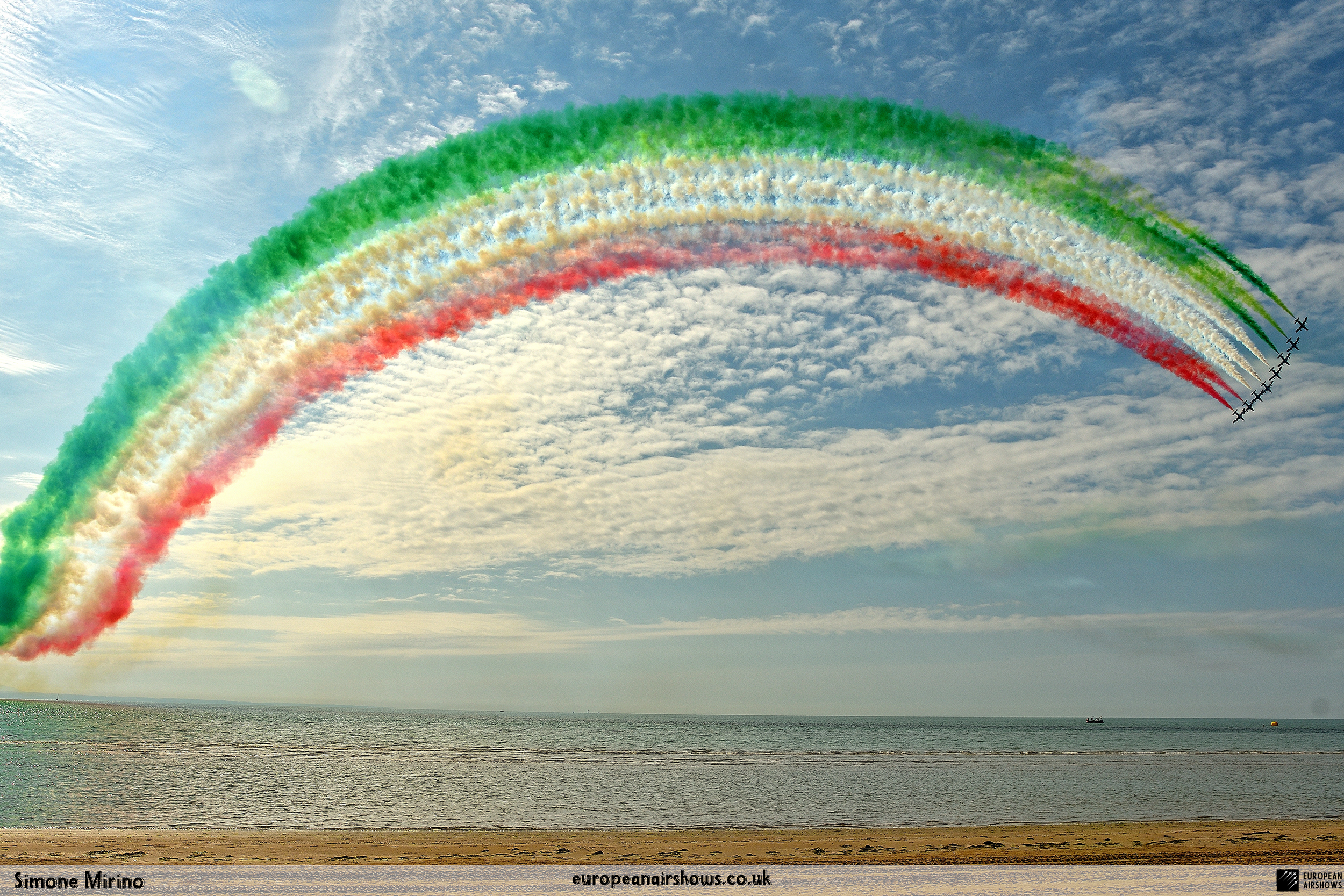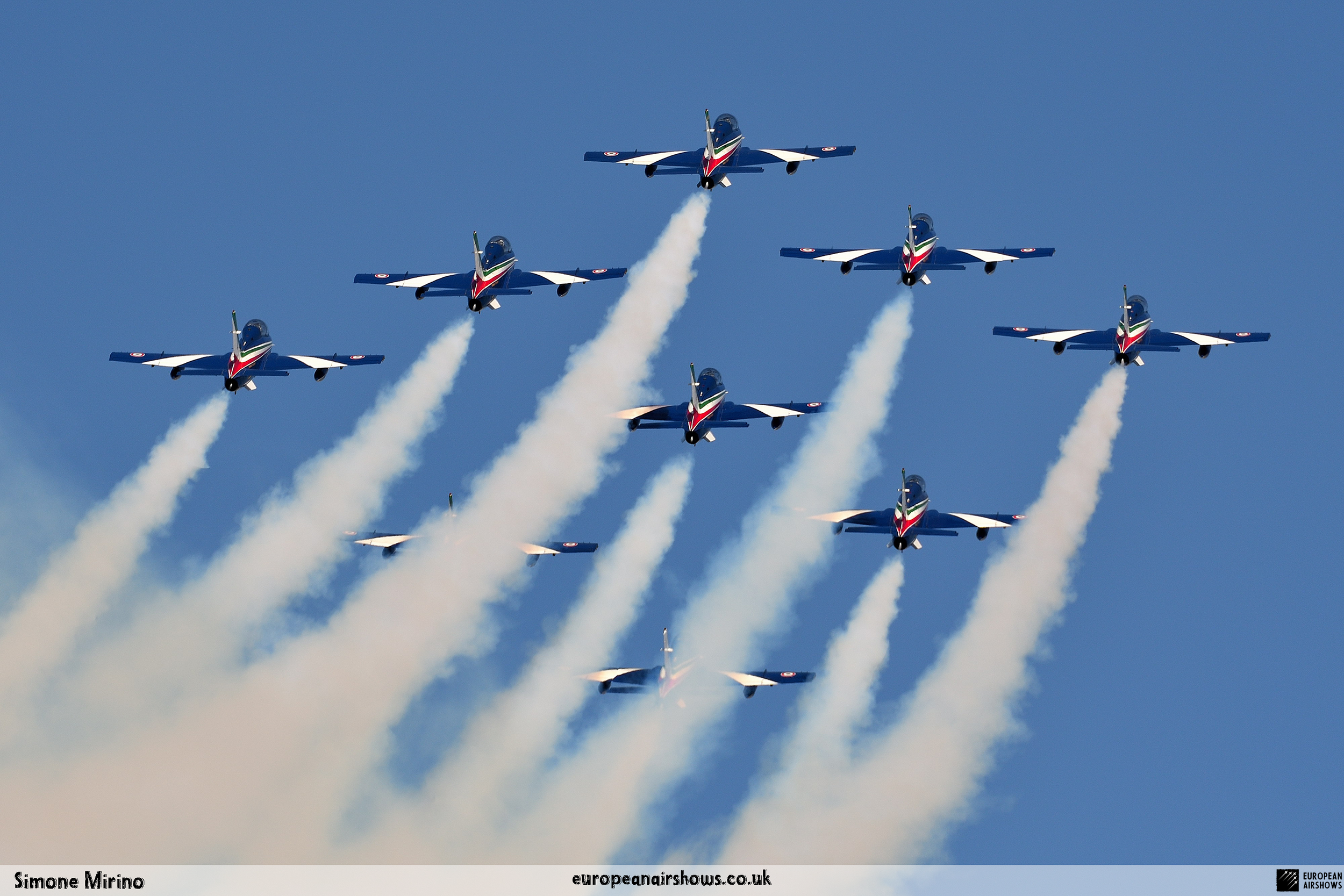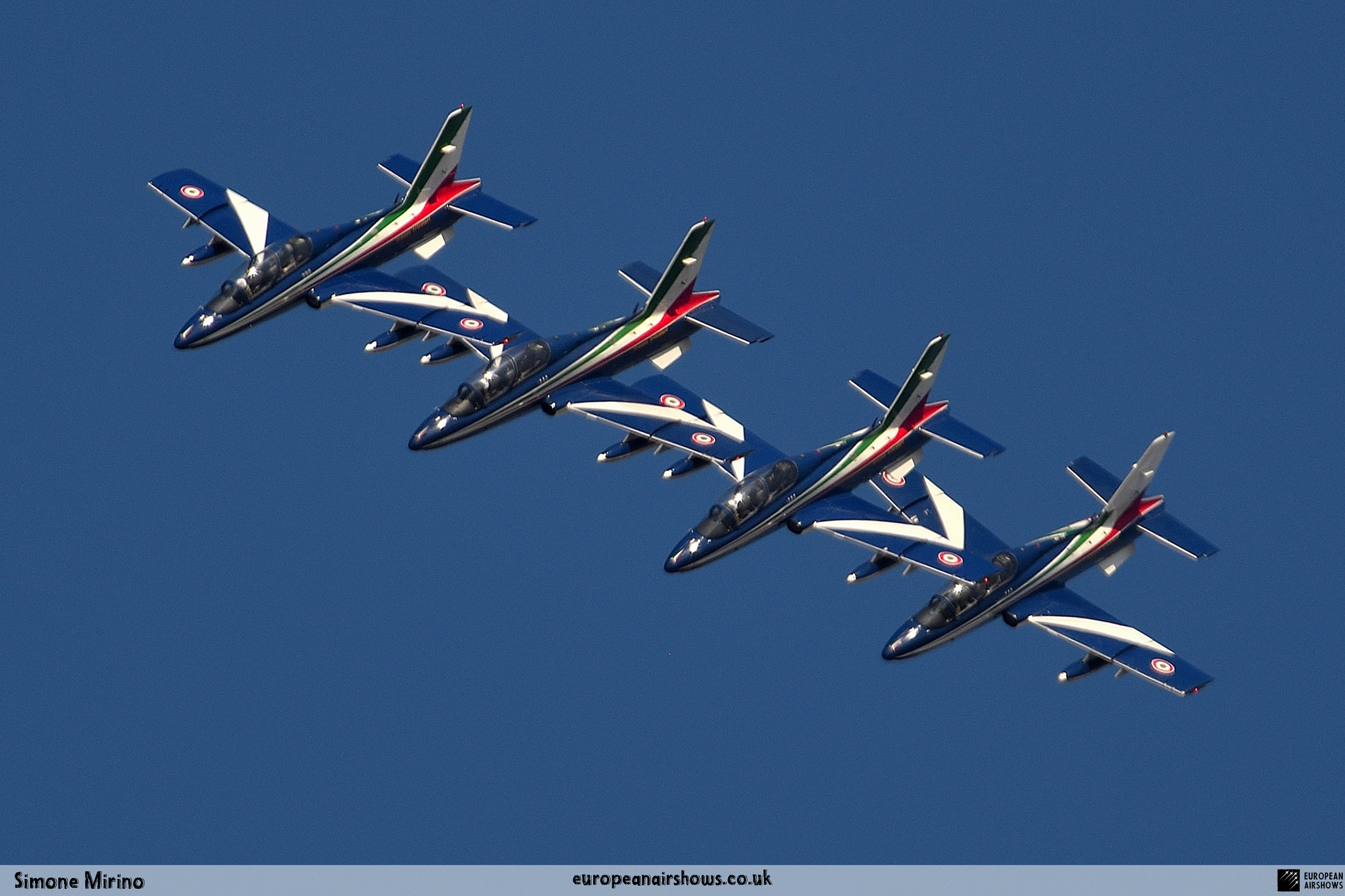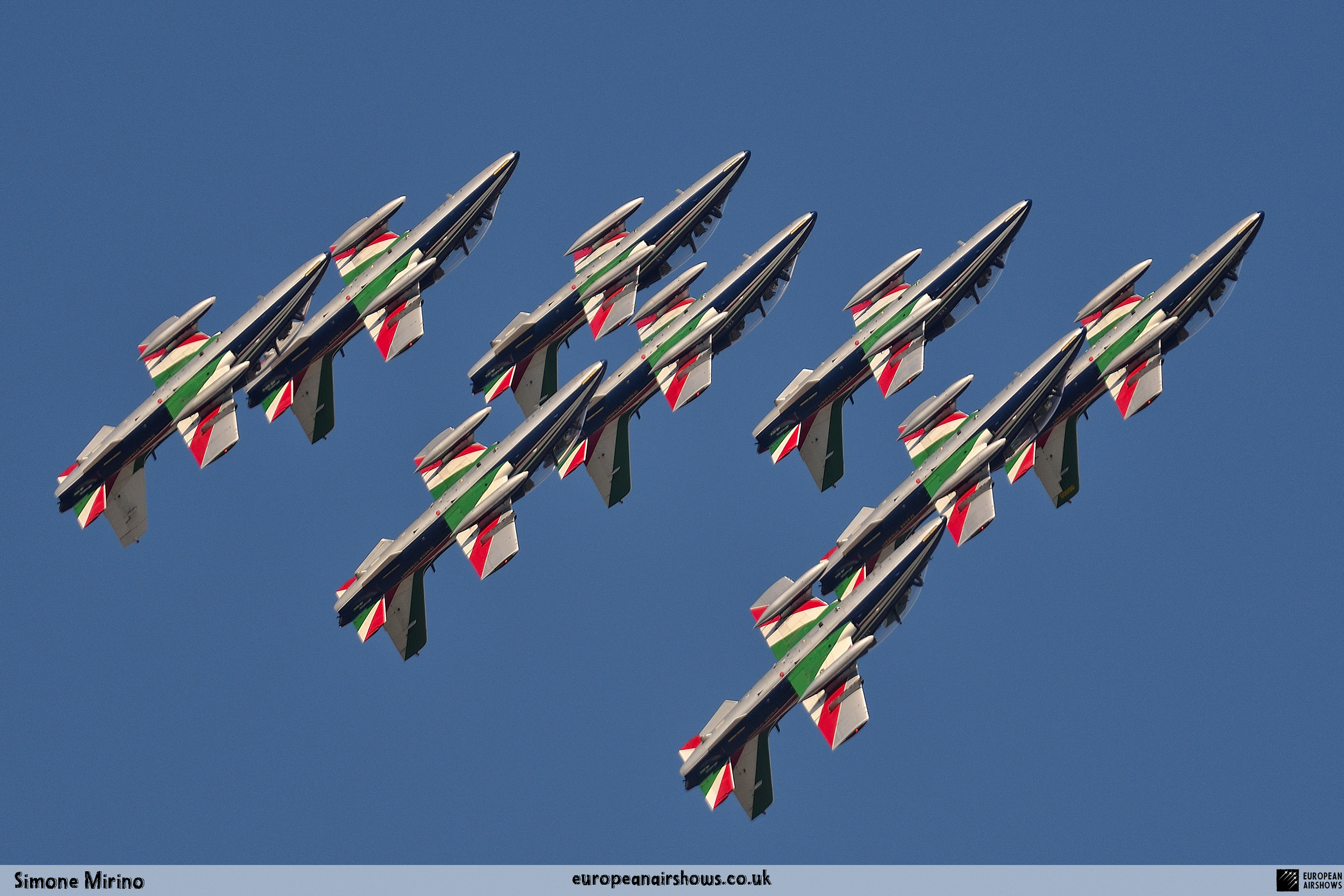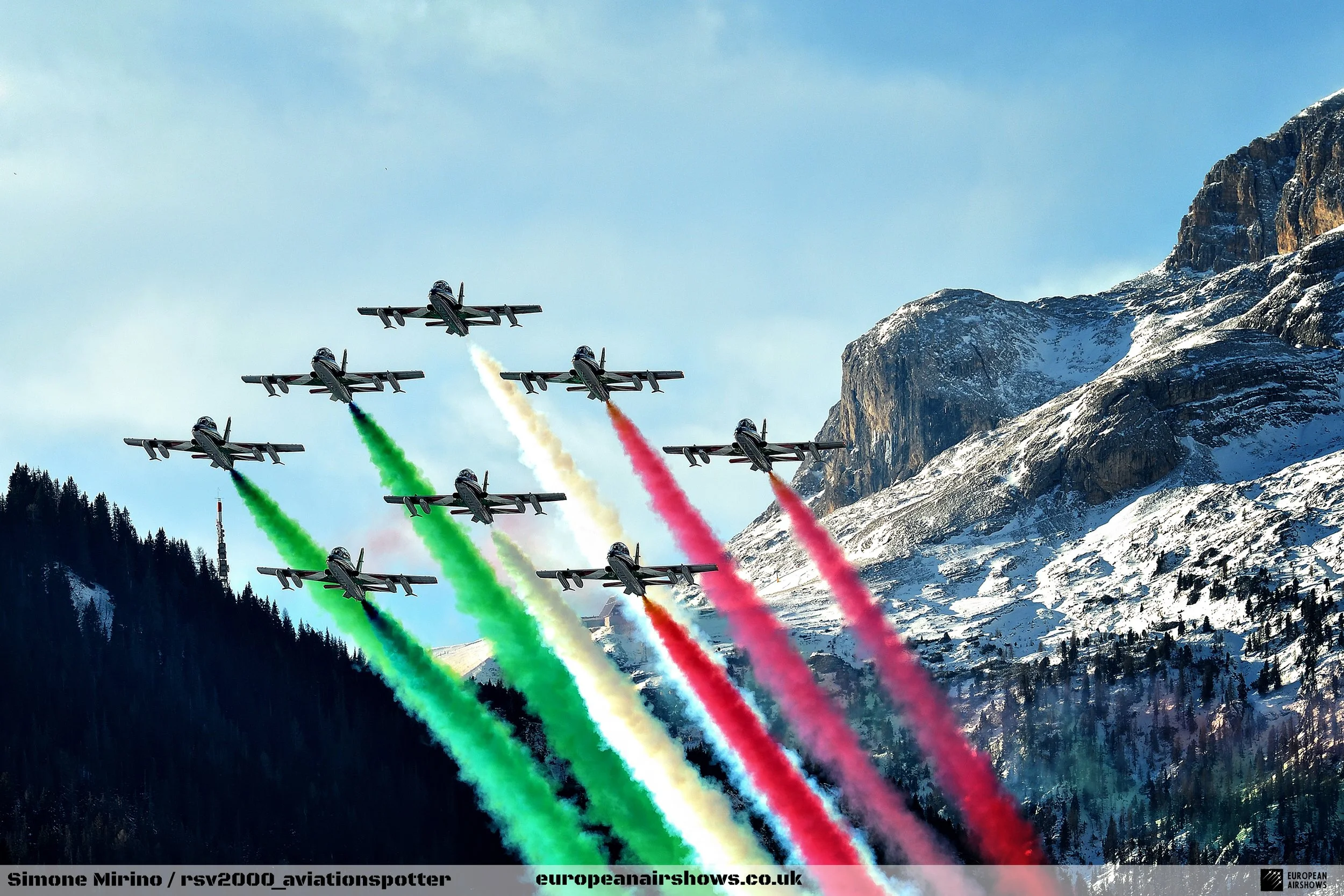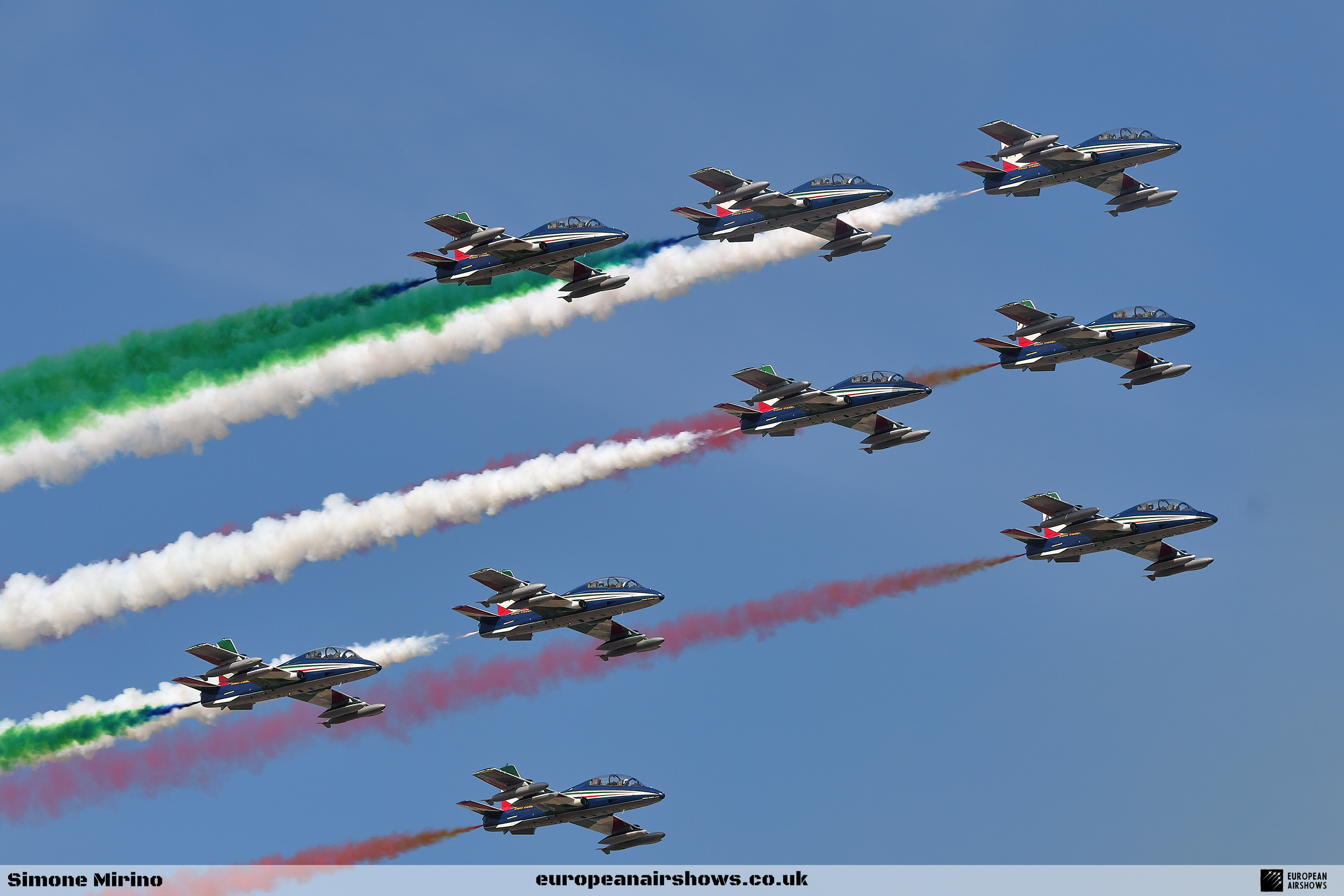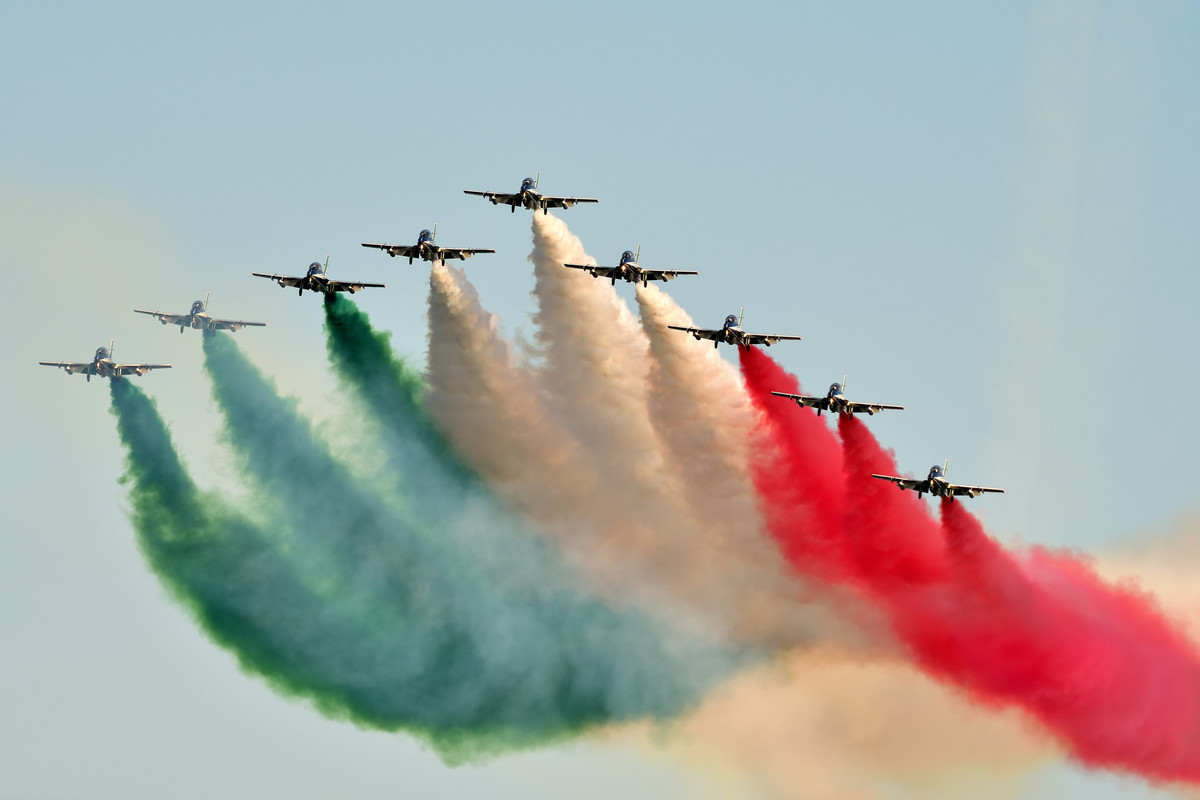
Frecce Tricolori
About the Team
Frecce Tricolori, officially known as the 313° Gruppo Addestramento Acrobatico, Pattuglia Acrobatica Nazionale (PAN), is the prestigious aerobatic demonstration team of the Italian Air Force. Based at Rivolto Air Base in the province of Udine, the team embodies Italian excellence in aviation and serves as a vibrant symbol of national pride. The Frecce Tricolori pilots the Aermacchi MB-339-A/PAN, a state-of-the-art two-seat fighter-trainer aircraft capable of reaching speeds up to 898 km/h at sea level. This aircraft is specifically modified for aerobatic performance, featuring advanced avionics and enhanced safety systems to support the intricate maneuvers performed during air shows.
The team is composed of ten aircraft, including nine planes flying in tight formation alongside a soloist, making Frecce Tricolori the largest aerobatic patrol in the world. This configuration allows them to execute a wide array of complex and dynamic maneuvers that captivate audiences globally. Their performances typically include around twenty distinct aerobatic maneuvers within a half-hour display, showcasing precision, coordination, and artistic flair. A key element of their visual spectacle is the use of colored smoke trails in green, white, and red—the colors of the Italian flag—introduced in 1963. These smoke trails enhance the visual impact of their formations, adding a vibrant and patriotic dimension to their shows.
Over the years, Frecce Tricolori has achieved numerous accolades, including accumulating 50,000 flying hours on the Aermacchi MB-339 by the year 2000. In 2005, they won the Best Exhibition award at the Royal International Air Tattoo in Fairford, England, and became the first non-Russian unit to receive the Russian Silver Medal for Aeronautical Merit. The team also performed a poignant fly-past honoring the legendary tenor Luciano Pavarotti during his funeral in Modena in 2007, leaving behind the iconic green, white, and red smoke trails. Looking ahead, the Italian Air Force announced on September 12, 2024, that Frecce Tricolori will transition to the two-engined Leonardo M-346 Master, marking a significant evolution in their fleet and ensuring their continued prominence in the world of aerobatic displays.
Team Overview
Number of Aircraft
10
Established
1961
Based
Rivolto Air Base
Aircraft Type
Aermacchi MB-339PAN
About the aircraft
The MB-339PAN is a specialized variant of the Aermacchi MB-339, designed specifically for the renowned Frecce Tricolori aerobatic team. This version features a smoke generator for dazzling aerial displays, while omitting the tip tanks found on other models. A total of 21 units were either newly constructed or converted from the standard MB-339A.
The Aermacchi MB-339 itself is a military jet trainer and light attack aircraft developed by the Italian aerospace manufacturer Aermacchi. Its inception dates back to the 1970s, initiated by the Italian Air Force’s need to replace the aging fleet of Aermacchi MB-326s. Rather than creating an entirely new design, Aermacchi based the MB-339 on the existing MB-326, resulting in significant design similarities between the two aircraft. The MB-339 was recognized for meeting all operational requirements while remaining the most cost-effective solution available. The aircraft made its inaugural flight on August 12, 1976, with the first production units delivered two years later.
Approximately half of the total MB-339 aircraft were commissioned by the Italian Air Force, while the remainder were exported to various international customers. In addition to its primary role in pilot training, the MB-339 has also been flown by the Frecce Tricolori, showcasing its capabilities in aerobatic performances. The aircraft has seen combat as well, being utilized by the Eritrean Air Force during the Eritrean–Ethiopian War from 1998 to 2000 and by the Argentine Naval Aviation during the Falklands War in 1982, where it primarily served as an attack aircraft. In Italy, the MB-339 is set to be succeeded by the newer Aermacchi M-345, marking a transition to more advanced training capabilities.
Team History
The origins of Frecce Tricolori are deeply rooted in Italy’s rich aviation heritage, tracing back to the early 20th century. The first acrobatic flight school in Italy was established in 1930 at Udine-Campoformido Airport, initiated by Colonel Rino Corso Fougier, commander of the 1st Fighter Wing. This pioneering group flew five Fiat C.R.20 aircraft and made their debut at the inaugural “Wing Day” air show on June 8, 1930, performing the “bomb” maneuver, a formation flying technique that would influence future aerobatic displays.
In the years leading up to World War II, the patrol of the Regia Aeronautica (Royal Italian Air Force) actively participated in numerous aviation events, including the 1938 inauguration of Milan-Linate Airport, where the chief patrol was led by Bruno Sartori, a decorated aviator awarded the Silver Medal of Military Valor. The war led to the dissolution of many military units, including Italian acrobatic patrols. However, after the war, aerobatic teams were reestablished, initially not officially recognized. The 51st Fighter Wing, equipped with US P-51D Mustangs and British Spitfire Mk.IX aircraft, began performing notable displays, such as a three-Spitfire formation at Padua Airport in September 1947. Concurrently, the 5th Wing formed another aerobatic team based on Spitfire aircraft, further enriching Italy’s aerial display repertoire.
The 1950s marked a significant period of growth and recognition for Italian aerobatics. In 1950, the Cavallino Rampante patrol was formed with four pilots from the 4th Wing flying D.H.100 Vampire aircraft. In 1953, the Guizzo team emerged from the 5th Wing, operating F-84G Thunderjet aircraft and gaining acclaim for their innovative “bomb” maneuver and performances across Europe, including a feature film titled “The Four of the Thundering Jet” in 1955. This team was later renamed Getti Tonanti before being succeeded by the Tigri Bianche of the 51st Fighter Wing in 1956. The rebirth of Cavallino Rampante in 1957 with F-86E Sabers led to landmark performances at events such as the Paris Air Show. That same year saw the introduction of two new teams: Diavoli Rossi from the 6th Fighter Wing, flying F-84F Thunderstreaks and gaining international popularity through a tour in the United States, and Lanceri Neri from the 2nd Aerobrigata, demonstrating exceptional skill with F-86E aircraft in performances including one in Iran in 1959.
In 1960, recognizing the need for a unified and permanent aerobatic team, the Italian Air Force established the Pattuglia Acrobatica Nazionale (PAN). Major Mario Squarcina, leader of the Diavoli Rossi, was tasked with forming this elite team by selecting the best pilots from various departments. On March 1, 1961, the 313th Aerobatic Training Group was founded at Rivolto Air Base, marking the official inception of Frecce Tricolori. The team’s first performance took place on May 1, 1961, at Trento-Gardolo Airport, featuring a high-intensity program with six North American F-86 Sabers. Tragically, just three days later, a pilot died in a flight incident, underscoring the inherent risks of aerobatic aviation.
Despite early setbacks, Frecce Tricolori continued to evolve and expand. In 1963, the team increased to nine aircraft plus a soloist and introduced colored smoke trails to enhance their visual displays. The following year, they upgraded to Fiat G.91PAN fighter-bombers, and in 1982, they transitioned to the Aermacchi MB-339 A/PAN MLU, modernizing their fleet and refining their performance capabilities. By 2000, the team had amassed 50,000 flying hours on the MB-339. Their achievements include winning the Best Exhibition award at the Royal International Air Tattoo in 2005 and receiving the Russian Silver Medal for Aeronautical Merit, a first for a non-Russian unit. In 2007, they performed a solemn fly-past honoring Luciano Pavarotti during his funeral in Modena, leaving behind the iconic green, white, and red smoke trails.
Looking to the future, while initial plans to transition to the Leonardo M.345 HET faced delays, the Italian Air Force announced on September 12, 2024, that Frecce Tricolori will adopt the two-engined Leonardo M-346 Master. This transition promises to enhance their performance capabilities and ensure that Frecce Tricolori remains at the forefront of aerobatic excellence. Throughout its illustrious history, Frecce Tricolori has not only demonstrated unparalleled technical and artistic skill in aerobatic flight but has also embodied the spirit and pride of the Italian Air Force and the nation it represents, solidifying its status as a revered symbol of Italy’s aviation legacy.
Did You Know?
- The Frecce Tricolori was founded on March 1, 1961, and operates out of Rivolto Air Base in the province of Udine, Italy, serving as the aerobatic demonstration team of the Italian Air Force.
- They perform with the Aermacchi MB-339-A/PAN, a two-seat fighter-trainer aircraft capable of reaching speeds up to 898 km/h at sea level.
- Comprising ten aircraft—nine flying in close formation with one soloist—the Frecce Tricolori is recognized as the world’s largest aerobatic team, renowned globally as a national symbol of Italy.
- Italy’s aerobatic tradition dates back to 1930 when Colonel Rino Corso Fougier established the first acrobatic flight school at Udine-Campoformido Airport, laying the foundation for future teams like the Frecce Tricolori.
- In 2005, the Frecce Tricolori won the award for best exhibition at the Royal International Air Tattoo in Fairford, England, and became the first non-Russian unit to receive the Russian Silver Medal for Aeronautical Merit.

















